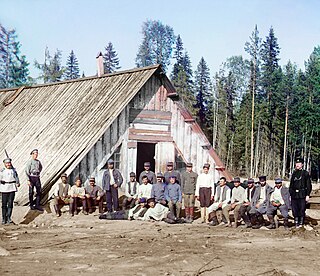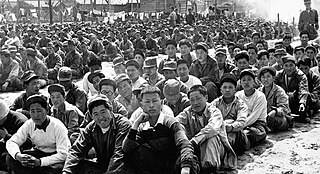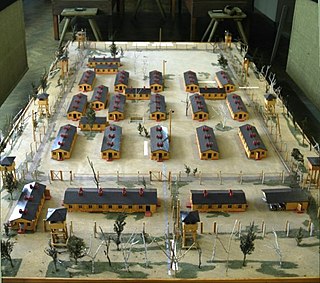Related Research Articles

A prisoner of war (POW) is a non-combatant—whether a military member, an irregular military fighter, or a civilian—who is held captive by a belligerent power during or immediately after an armed conflict. The earliest recorded usage of the phrase "prisoner of war" dates back to 1610.

The Great Escape is a 1963 American epic adventure suspense war film starring Steve McQueen, James Garner and Richard Attenborough and featuring James Donald, Charles Bronson, Donald Pleasence, James Coburn, Hannes Messemer, David McCallum, Gordon Jackson, John Leyton and Angus Lennie. It was filmed in Panavision.

A prisoner-of-war camp is a site for the containment of enemy fighters captured by a belligerent power in time of war.

Marlag und Milag Nord was a Second World War German prisoner-of-war camp complex for men of the British and Canadian Merchant Navy and Royal Navy. It was located around the village of Westertimke, about 30 km (19 mi) north-east of Bremen, though in some sources the camp's location is given as Tarmstedt, a larger village about 4 km (2.5 mi) to the west. There were also American merchant seamen detained here as well as some U.S. Navy personnel.

Stalag Luft III was a Luftwaffe-run prisoner-of-war (POW) camp during the Second World War, which held captured Western Allied air force personnel.

Island Farm, also called Camp 198, was a prisoner of war camp on the outskirts of the town of Bridgend, South Wales. It hosted a number of Axis prisoners, mainly German, and was the scene of the largest escape attempt by German POWs in Britain during World War II. Near the end of the war it was renamed Special Camp XI and used to detain many senior SS military leaders who were awaiting extradition to the Nuremberg trials.
Camp Albuquerque was an American World War II POW camp in Albuquerque, New Mexico that housed Italian and German prisoners of war. From this branch camp, the POWs did mostly farm labor, from 1943 to 1946. Most of these POWs were transferred from Camp Roswell, which was a base or main POW camp for New Mexico. Camp Lordsburg, New Mexico, and Camp El Paso, Texas, were also base camps.

The Bowmanville POW camp also known as Camp 30 was a Canadian-run POW camp for German soldiers during World War II located in the community of Bowmanville, Ontario in Clarington, Ontario, Canada. In September 2013, the camp was designated a National Historic Site of Canada.

Oflag VII-B was a World War II German prisoner-of-war camp for officers (Offizierlager), located in Eichstätt, Bavaria, about 100 km (62 mi) north of Munich.

Neys Provincial Park is a Natural Environment Class provincial park on the north shore of Lake Superior, just west of Marathon, Ontario, Canada. This 5,383-hectare (13,300-acre) park includes the historic Coldwell Peninsula and the surrounding island system consisting of Pic Island, Detention Island, and the Sullivan Islands.

The McKenzie Break is a 1970 DeLuxe Color British war drama film directed by Lamont Johnson, starring Brian Keith as Jack Connor, an intelligence officer investigating recent disturbances at a prisoner of war (POW) camp in Scotland. The POWs are led by the charismatic and ruthless Willi Schlüter.

Elmira Prison was originally a barracks for "Camp Rathbun" or "Camp Chemung", a key muster and training point for the Union Army during the American Civil War, between 1861 and 1864. The 30-acre (120,000 m2) site was selected partially due to its proximity to the Erie Railroad and the Northern Central Railway, which crisscrossed in the midst of the city. The Camp fell into disuse as the war progressed, but its "Barracks #3" was converted into a military prison in the summer of 1864. It was the prison holding the largest number of Confederate POWs. Its capacity was 4,000, but it held 12,000 within one month of opening. A different source says that Camp Rathbun had a capacity of 6,000 recruits, but that it was turned into a prison for 10,000 and "the Union Commissary General was given just 10 days to make it happen.
Danger Within is a 1959 British war film set in a prisoner of war camp in Northern Italy during the summer of 1943. A combination of POW escape drama and whodunit, the movie is based upon the 1952 novel Death in Captivity by Michael Gilbert, who had been a prisoner of war held by the Italians.

The Selarang Barracks incident, also known as the Barrack Square incident or the Selarang Square Squeeze, was a revolt of British and Australian prisoners-of-war (POWs) interned in a Japanese camp in Changi, Singapore.

Operation Kiebitz was a failed German operation during World War II to organize the escape of four skilled U-boat commanders from a Canadian prisoner of war camp in Bowmanville, Ontario. The subsequent counter operation by the Royal Canadian Navy, Operation Pointe Maisonnette, became a key engagement in the Battle of the St. Lawrence and was also successful in thwarting the Germans' plan.

Stalag Luft I was a German World War II prisoner-of-war (POW) camp near Barth, Western Pomerania, Germany, for captured Allied airmen. The presence of the prison camp is said to have shielded the town of Barth from Allied bombing. About 9,000 airmen – 7,588 American and 1,351 British and Canadian – were imprisoned there when it was liberated on the night of 30 April 1945 by Russian troops.

Members of the German military were interned as prisoners of war in the United States during World War I and World War II. In all, 425,000 German prisoners lived in 700 camps throughout the United States during World War II.

The Palawan massacre occurred on 14 December 1944, during World War II, near the city of Puerto Princesa in the Philippine province of Palawan. Allied soldiers, imprisoned near the city, were killed by Imperial Japanese soldiers.
References
- ↑ Coates, Ken and Holroyd, Carin. Pacific Partners, p. 44
- ↑ Chisholm, B., and Gutsche, A. Superior: Under the Shadow of the Gods, Lynx Images, 1998, p. 161
- ↑ Angler POW Camp: The Escape that Shocked the Country, Lynx Images, http://www.lynximages.com/POW.htm
- 1 2 Chisholm, B., and Gutsche, A. Superior: Under the Shadow of the Gods, Lynx Images, 1998, p. 163
- ↑ Mackey, Doug. Prisoners of War: Lest we Forget, Community Voices: Heritage Perspectives, February 15, 2002, http://www.pastforward.ca/perspectives/feb_152002.htm